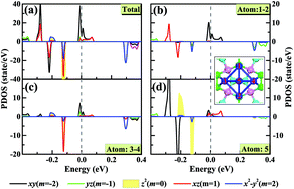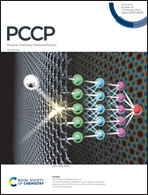Band gap and magnetic engineering of penta-graphene via adsorption of small transition clusters†
Abstract
Penta-graphene has been intensively studied owing to its superior properties such as being an intrinsic semiconductor and having two dimensional stability. However, the nonmagnetic character makes it difficult for straightforward application in the fields of spintronic or information storage. Here, the deposition effects of Fe-group and Co-group transition metal (TM = Fe, Ru, Os; Co, Rh, Ir) clusters on the penta-graphene have been systemically investigated for their electronic and magnetic properties by using density functional theory (DFT) calculations. We found that the TM deposition stability on penta-graphene is overall greater than that on graphene. Importantly, TM adatoms (adclusters) not only change penta-graphene from being a wide band-gap semiconductor to a narrow band-gap semiconductor, but also introduce large magnetic moments into systems simultaneously. It is worth noting that the Ir5 cluster on penta-graphene is a good candidate for realizing the magnetic half-metallic materials. Our calculated results demonstrate that adatoms can exhibit large out-of-plane magnetic anisotropy energy, e.g., the Os adatom presents the largest value of 113 meV. Therefore, from the application point of view, magnetic functionalization of penta-graphene by TM clusters facilitates its application as a spintronic device or a high-density information storage device.

- This article is part of the themed collection: 2020 PCCP HOT Articles


 Please wait while we load your content...
Please wait while we load your content...